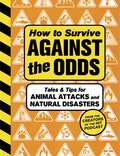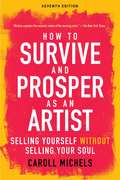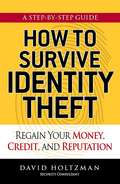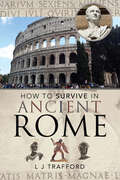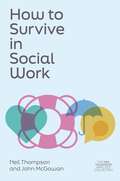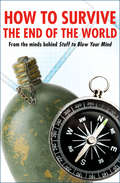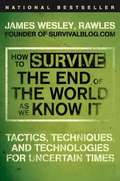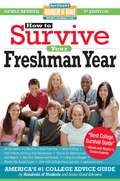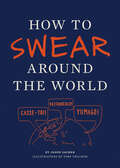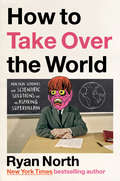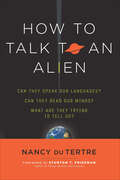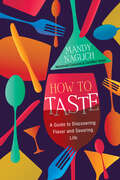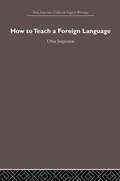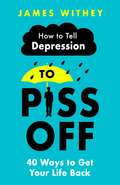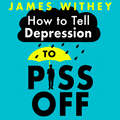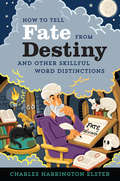- Table View
- List View
How to Survive Against the Odds: Tales and Tips for Animal Attacks and Natural Disasters
by WonderyInspired by Wondery’s hit podcast Against the Odds—learn how to survive whatever nature can throw at you through gut-twisting true stories of survival on the brinkHow to Survive Against the Odds places you at the center of fifteen real life-or-death scenarios. Each story explores the physiological responses of the human body under unbearable conditions, how to counteract them, and strategies for survival from doctors and psychologists. Through these tales, we see the grit, willpower, and know-how needed to navigate out of a host of merciless situations.This invaluable survival guide includes tips on how to endure being:ADRIFT AT SEA: Learn how to cure turtle meat, procure potable water, and survive on a life raft.MAULED BY A BEAR: Black bears? Fight back. Grizzly bears? Play dead. Polar bears? Start praying. You’ll learn how to triage wounds using the MARCH method and how to spot the difference between a bear’s bluff charge and an actual attack.BURIED BY AN EARTHQUAKE: Find out how to survive the initial crush, maintain your sanity if trapped under the rubble, and “think away your hunger.”And so much more!This might just be the most important book you’ll ever read. Armed with the information in How to Survive Against the Odds and when faced with similar threats, you may also find that you have what it takes to defy death and live to tell your story.
How to Survive and Prosper as an Artist: Selling Yourself without Selling Your Soul (Seventh Edition)
by Carol Michels“Michels explodes the romantic notion of the starving artist.” —The New York Times “Michels is a tough but compassionate advocate, savvy in the ways of the world and the demands on artists in this materialistic society.” —The Miami Herald Written for fine artists ready to launch their careers as well as experienced artists who wish to relaunch their careers, How to Survive and Prosper as an Artist, Seventh Edition, an acclaimed guide, empowers artists to take control of their careers to create a fulfilling life and earn a decent income. In this newly revised edition, Caroll Michels continues to demystify the inner workings of the art world and challenge the status quo. New chapters discuss such topics as: New business models for artists: Going to the extreme The use of social media and website development as marketing and publicity tools and what does and doesn’t work The confusion between the “art-buying public” and the “general public” and their differences New suggestions for establishing and calculating prices for artwork Neighborhood gentrification and the growing challenges of securing a reasonably priced live/work space How dealers find artists, how to negotiate with dealers, and how to understand a dealer’s agenda Using her own experiences as an artist as well as the experiences of her clients, Michels crafts a must-read guidebook for anyone interested in embarking upon a successful career as an artist.
How to Survive Identity Theft: Regain Your Money, Credit, and Reputation
by David HoltzmanIdentity theft is at an all-time high. In one notorious case, a criminal racked up more than $100,000 of debt in the name of his victim. The thief bought homes, motorcycles, and handguns in the victim’s name. The victim and his wife spent more than four years and $15,000 to clear his name.Money, credit, and even lives are at stake when an identity is stolen. Yet many people don’t know what legal protections exist. You need to learn what to do when your name, credit card number, or other information gets into the wrong hands. Security expert David Holtzman offers you clear, concise advice on how to reduce the chances of fraud and what steps victims need to take to reclaim their lives. An extensive resource list offers tools to draw up a plan to rebuild credit and reputation.Thieves are roaming the Internet. But with this essential guide, their victims can even the score!
How to Survive in Ancient Rome
by L J TraffordWhat you’d need to know if you time-traveled to Ancient Rome—from local customs to clothing to religion to housing to food.Imagine you were transported back in time to Ancient Rome and you had to start a new life there. How would you fit in? Where would you live? What would you eat? Where would you go to have your hair done? Who would you go to if you got ill, or if you were mugged in the street? All these questions, and many more, are answered in this new how-to guide for time travelers. This lively and engaging twist on ancient history reveals how to deal with the many problems and new experiences you would face—and thrive in this strange new environment.
How to Survive in Social Work (The Neil Thompson Practice Collection)
by Neil Thompson John McGowanSocial worker. You're a helping hand, a rock in the tempest, a friendly face through the hard times, and a catalyst for change. But what about you? How do you keep going when the pressure just keeps rising?In this no-nonsense handbook, Neil Thompson and John McGowan distil years of social work expertise into key strategies to overcome the challenges that come with the profession. Each chapter is full of clear, practical advice on staying resilient in the face of tough situations, whether they're political, social, or economic. Handy frameworks and expert advice will strengthen your practice and give you a solid structure to build on, helping you fulfil your potential as a social worker and provide better support for your clients. Social work is tough, but with the guidance and support in this book you can learn to tackle the challenges and thrive as a force for change.
How to Survive the End of the World
by HowstuffworksFrom the creative editorial minds at HowStuffWorks.com comes a volume of entertaining advice to help readers survive the end of the world as we know itIn response to our readers, who are particularly curious about both doomsday scenarios and survivalist techniques, HowStuffWorks.com presents Surviving the End of the World. There are many possible ends in store for our world. Zombie hordes could rise up and eat our brains. A viral pandemic could sweep the globe, decimating the human population but for a hearty, immune few. Or a catastrophic solar superstorm might render all electronics on the planet inert, causing a civilization-ending panic. You won't survive hanging around the dead, the near-dead, or the undead, so in case of Armageddon, head for the hills. Perhaps you're being chased and leave with nothing but a machete and your will to live. Perhaps you actually have time to pack, but you aren't sure what you might need. Once you're in the wilderness, how will you cope? This volume will advise you on such subjects as building shelter in the forest with your bare hands, hunting edible berries in the summer and edible termites year-round, and avoiding the critical stages of dehydration. We even include tips on making moonshine and chocolate, since you'll need something to sweeten the New World Order. If the world as we knew it came to an end, we'd like to think we'd survive. At least, we'd like to think that this book, with its equal parts education and laughter, gives our readers an advantage. Join us for the apocalypse. Let's survive together.
How to Survive the End of the World as We Know It: Tactics, Techniques, and Technologies for Uncertain Times
by Rawles James WesleyRead James Wesley, Rawles's posts on the Penguin BlogIn the vein of Sam Sheridan's The Disaster Diaries, a comprehensive guide to preparing for the apocalypse! With the recent economic crisis, formerly unimaginable scenarios have become terrifyingly real possibilities- learn how to prepare for the worstGlobal financial collapse, a terrorist attack, a natural catastrophe-all it takes is one event to disrupt our way of life. We could find ourselves facing myriad serious problems from massive unemployment to a food shortage to an infrastructure failure that cuts off our power or water supply. If something terrible happens, we won't be able to rely on the government or our communities. We'll have to take care of ourselves.In How to Survive the End of the World as We Know It, James Rawles, founder of SurvivalBlog.com, clearly explains everything you need to know to protect yourself and your family in the event of a disaster-from radical currency devaluation to a nuclear threat to a hurricane. Rawles shares essential tactics and techniques for surviving completely on your own, including how much food is enough, how to filter rainwater, how to protect your money, which seeds to buy for your garden, why goats are a smart choice for livestock, and how to secure your home. It's the ultimate guide to total preparedness and self-reliance in a time of need.
How to Survive the End of the World as We Know It
by Rawles James WesleyRead James Wesley, Rawles's posts on the Penguin Blog In the vein of Sam Sheridan's The Disaster Diaries, a comprehensive guide to preparing for the apocalypse! With the recent economic crisis, formerly unimaginable scenarios have become terrifyingly real possibilities- learn how to prepare for the worst Global financial collapse, a terrorist attack, a natural catastrophe-all it takes is one event to disrupt our way of life. We could find ourselves facing myriad serious problems from massive unemployment to a food shortage to an infrastructure failure that cuts off our power or water supply. If something terrible happens, we won't be able to rely on the government or our communities. We'll have to take care of ourselves. In How to Survive the End of the World as We Know It, James Rawles, founder of SurvivalBlog.com, clearly explains everything you need to know to protect yourself and your family in the event of a disaster-from radical currency devaluation to a nuclear threat to a hurricane. Rawles shares essential tactics and techniques for surviving completely on your own, including how much food is enough, how to filter rainwater, how to protect your money, which seeds to buy for your garden, why goats are a smart choice for livestock, and how to secure your home. It's the ultimate guide to total preparedness and self-reliance in a time of need.
How to Survive Your Freshman Year
by Frances Northcutt Yadin Kaufmann Ed.D. Scott Silverman Mark W. BernsteinHow to Survive Your Freshman Year offers incoming college freshmen the experience, advice, and wisdom of their peers: hundreds of other students who have survived their first year of college and have something interesting to say about it. Based on interviews with hundreds of college students at every type of higher-learning institution across the country, this book has insights on every aspect of college life, including, what to take to the dorm, living with roommates, Facebook and other social networks, extracurricular activities, choosing classes, studying, going abroad, finances, food, the social scene, doing laundry, staying in touch with friends and family, and much more. Highly readable, much of the book consists of short snippets with some interesting insight and advice from the college students interviewed. The book also includes expert input from college advisors and officers.
How to Swear Around the World
by Jason SacherWith this helpful guide, learn to tell people off like a native no matter where you are in the world.An essential phrasebook for the world traveler, How to Swear Around the World features dozens of favorite curses, insults, and sayings from all over the globe. Get rid of a pesky hanger-on in Brazil by telling him to dig for potatoes—vai ceifar batatas. To express disgust toward your brown-nosing German friend, accuse him of being a bicycle-rider—radfahrer, or tell someone off in Laos by letting him know you think his mother enjoys keeping intimate company with dogs—Ma see mea mung! Make new friends and enemies abroad with this handy guide filled with fighting words, scatological expressions, dozens of ways to insult someone’s mother, and many other suitably offensive phrases.Also features phonetic pronunciations and handy illustrations to provide guidance to these colorful exclamations.“As useful as it is hilarious, Sacher’s How to Swear Around the World teaches readers all kinds of vulgar phrases in dozens of different languages. Feel free to call Expedia and curse out their airfare prices using any of the book’s quotes.” —Complex.com
How to Take Over the World: Practical Schemes and Scientific Solutions for the Aspiring Supervillain
by Ryan North&“Comic book fans will fall hard for this delightfully daffy guidebook. . . . Exuberant, optimistic, and just plain fun, How to Take Over the World will both surprise and delight.&” —EsquireA book this informative should be a crime!Taking over the world is a lot of work. Any supervillain is bound to have questions: What&’s the perfect location for a floating secret base? What zany heist will fund my wildly ambitious plans? How do I control the weather, destroy the internet, and never, ever die? Bestselling author and award-winning comics writer Ryan North has the answers. In this introduction to the science of comic-book supervillainy, he details a number of outlandish villainous schemes that harness the potential of today&’s most advanced technologies. Picking up where How to Invent Everything left off, his explanations are as fun and elucidating as they are completely absurd. You don&’t have to be a criminal mastermind to share a supervillain&’s interest in cutting-edge science and technology. This book doesn&’t just reveal how to take over the world—it also shows how you could save it. This sly guide to some of the greatest threats facing humanity accessibly explores emerging techniques to extend human life spans, combat cyberterrorism, communicate across millennia, and finally make Jurassic Park a reality.
How to Talk to an Alien
by Nancy du Tertre“Even for nonbelievers, the author’s palpable excitement over the subject matter is endearing and entertaining. Ufologists won’t want to miss this work.” —Foreword ReviewsIn 1972, American astronomer and ufologist J. Allen Hynek first coined the term “close encounter.” He also identified three types of close encounters with UFOs. Since then, several more types of encounters have been proposed. A close encounter of the fourth kind is an alien abduction. A closer encounter of the fifth kind is voluntary, bilateral contact with an alien species.We are no longer just looking at strange flying objects in the skies; now we are beginning to interact with the actual pilots, crew, and passengers!Do aliens exist? In 2013, one poll showed that nearly half of all Americans (48 percent) believe UFOs may be a sign of extraterrestrial visitation; another found that 10 percent of Americans claim to have actually witnessed an actual UFO; and yet another showed that 2.9 million Americans believe they had actually been abducted by aliens.If aliens exist and are visiting us, we need to talk!Who will speak to them on behalf of planet Earth? Who can translate their intentions—good or evil—toward the human race? How can we learn about their advanced technologies? Can aliens speak human languages?These and even more fascinating questions are all addressed in How to Talk to an Alien.“Nancy du Tertre covers the various considerations involved with extraterrestrial communication, including the use of alien technology, ET linguistics, and the possibility of using telepathy and dreams. Her handbook for the future should be on every thinking person’s bookshelf.” —Jim Marrs, New York Times–bestselling author
How to Taste: A Guide to Discovering Flavor and Savoring Life
by Mandy NaglichPerfect for foodie fans of Salt, Fat, Acid, Heat as well as Cork Dork and The Flavor Equation, this instant classic is both a sumptuous behind-the-scenes tour and a fun, appetizing, and informative how-to that covers everything from wine and cheese to ice cream and honey, tea, chocolate, and even water, from the science of taste and the rituals of creating a fine-tuned palate, to plucking flavor descriptions from the tip of your tongue, and learning how appreciating food can help you appreciate life.You love to eat. But do you know how to taste?On a delectable sensory romp through the science of flavor, award-winning professional taster Mandy Naglich, one of less than 100 Advanced Cicerones in the world, gives you a seat at the table in the elite world of master tasters – scientists, professional tasters, sommeliers, umami ushers and more – divulging the secrets behind their perfected palates so you, too, can become a super taster. Whether it&’s a meaningful meal or a favorite nostalgic road trip snack, we know what we like to eat. But even when it comes to the most vivid and memorable dishes it&’s tough to say what exactly makes them so delicious. Now award-winning expert certified food and beverage taster and lifestyle journalist Mandy Naglich reveals how to hone your tasting superpowers like a pro. Take a seat beside highly-trained cheese analysts, world-class sommeliers, competitive whiskey tasters, internationally recognized chefs, and sensory scientists as experts divulge the secrets to discerning the notes in a range of ingredients, from a dab of honey to a spoonful of olive oil—and even a sip of mineral water. Discover why a James Beard award-winner was visibly nervous before a blindfolded taste test on Top Chef Masters, and how coffee farmers base growing practices on the palate of one world-renowned authority. Learn why your taste buds respond to variables such as food temperature and background music. What the flavor distinction is between a pomme fruit and a stone fruit, how to judge the acidity of anything, from a cup of tea to a square of dark chocolate—and how understanding flavor can impact the way you understand the world. A rich journey for the flavor-obsessed, this instant classic is both a practical guide and a sumptuous meditation on how to savor all things delicious—on the plate and in life.
How to Teach a Foreign Language
by Otto JespersenThis book was first published in 1904, How to Teach a Foreign Language is a valuable contribution to the field of English Language and Linguistics.
How To Tell Depression to Piss Off: 40 Ways to Get Your Life Back
by James WitheyDepression sucks, but you don't.Trying to manage the range of symptoms that depression throws at you is like navigating the dark ocean floor when you are without a torch and don't know how to swim. How do you manage something that feels utterly unmanageable? How do you get through each day when depression is telling you you're a worthless lump of camel spleen? What you need is a guide. A really good one. You need to know what works and what to do.This book gives you 40 ways to get to a better place with depression. They are born out of the author's personal experience of clinical depression and his many years of working as a counsellor helping people with their mental health. James lives with depression and knows its lies, the traps it makes and how to dodge when it starts spitting bile in your face. Nice, eh?The ways include:- Kick your cuckoo. We don't usually encourage violence towards birds, but no cuckoos are actually harmed so don't call the RSPCA just yet. In this chapter you're encouraged to imagine your depression as an external 'thing' (no humans or animals, of course!) and that you can 'kick out', which is great fun. - Whose voice is it anyway? Spoiler alert! That nasty voice you're hearing isn't you; it's depression. The illness. When you start to recognise its voice you can start swearing back and who doesn't love a bit of swearing?- Don't listen to the lies. We all tell little lies sometimes, right? But depression is the biggest liar in the whole universe. It makes Pinocchio look like Mother Theresa. Be the lie detector to depression's fibs; call it out on its fraudulent nonsense. - Do the opposite. Depression will try to convince you to stay in bed, don't go out, don't wash, don't eat, don't phone anyone. Be Contrary Mary and do the exact opposite of what depression tells you because it never has your interests at heart. Plus, doing the opposite feels like you're a rebel, and rebels are cool (see Star Wars). At whatever point you're at with your depression, this book can help and provide some laughs along the way - hooray! - because you really need it with this bloody illness.
How To Tell Depression to Piss Off: 40 Ways to Get Your Life Back
by James WitheyDepression sucks, but you don't.Trying to manage the range of symptoms that depression throws at you is like navigating the dark ocean floor when you are without a torch and don't know how to swim. How do you manage something that feels utterly unmanageable? How do you get through each day when depression is telling you you're a worthless lump of camel spleen? What you need is a guide. A really good one. You need to know what works and what to do.This book gives you 40 ways to get to a better place with depression. They are born out of the author's personal experience of clinical depression and his many years of working as a counsellor helping people with their mental health. James lives with depression and knows its lies, the traps it makes and how to dodge when it starts spitting bile in your face. Nice, eh?The ways include:- Kick your cuckoo. We don't usually encourage violence towards birds, but no cuckoos are actually harmed so don't call the RSPCA just yet. In this chapter you're encouraged to imagine your depression as an external 'thing' (no humans or animals, of course!) and that you can 'kick out', which is great fun. - Whose voice is it anyway? Spoiler alert! That nasty voice you're hearing isn't you; it's depression. The illness. When you start to recognise its voice you can start swearing back and who doesn't love a bit of swearing?- Don't listen to the lies. We all tell little lies sometimes, right? But depression is the biggest liar in the whole universe. It makes Pinocchio look like Mother Theresa. Be the lie detector to depression's fibs; call it out on its fraudulent nonsense. - Do the opposite. Depression will try to convince you to stay in bed, don't go out, don't wash, don't eat, don't phone anyone. Be Contrary Mary and do the exact opposite of what depression tells you because it never has your interests at heart. Plus, doing the opposite feels like you're a rebel, and rebels are cool (see Star Wars). At whatever point you're at with your depression, this book can help and provide some laughs along the way - hooray! - because you really need it with this bloody illness.
How To Tell Depression to Piss Off: 40 Ways to Get Your Life Back
by James WitheyDepression sucks, but you don't.Trying to manage the range of symptoms that depression throws at you is like navigating the dark ocean floor when you are without a torch and don't know how to swim. How do you manage something that feels utterly unmanageable? How do you get through each day when depression is telling you you're a worthless lump of camel spleen? What you need is a guide. A really good one. You need to know what works and what to do.This book gives you 40 ways to get to a better place with depression. They are born out of the author's personal experience of clinical depression and his many years of working as a counsellor helping people with their mental health. James lives with depression and knows its lies, the traps it makes and how to dodge when it starts spitting bile in your face. Nice, eh?The ways include:- Kick your cuckoo. We don't usually encourage violence towards birds, but no cuckoos are actually harmed so don't call the RSPCA just yet. In this chapter you're encouraged to imagine your depression as an external 'thing' (no humans or animals, of course!) and that you can 'kick out', which is great fun. - Whose voice is it anyway? Spoiler alert! That nasty voice you're hearing isn't you; it's depression. The illness. When you start to recognise its voice you can start swearing back and who doesn't love a bit of swearing?- Don't listen to the lies. We all tell little lies sometimes, right? But depression is the biggest liar in the whole universe. It makes Pinocchio look like Mother Theresa. Be the lie detector to depression's fibs; call it out on its fraudulent nonsense. - Do the opposite. Depression will try to convince you to stay in bed, don't go out, don't wash, don't eat, don't phone anyone. Be Contrary Mary and do the exact opposite of what depression tells you because it never has your interests at heart. Plus, doing the opposite feels like you're a rebel, and rebels are cool (see Star Wars). At whatever point you're at with your depression, this book can help and provide some laughs along the way - hooray! - because you really need it with this bloody illness.
How to Tell Fate from Destiny: And Other Skillful Word Distinctions
by Charles Harrington Elster&“In this part-thesaurus, part-hilarious manual of style, Elster breaks down the most common mistakes of the English language.&”—Booklist If you have trouble distinguishing the verbs imitate and emulate, the relative pronouns that and which, or the adjectives pliant, pliable, and supple, never fear—How to Tell Fate from Destiny is here to help! With more than 500 headwords, the book is replete with advice on how to differentiate commonly confused words and steer clear of verbal trouble. Whether you&’re a boomer, a Gen-Xer, or a millennial, if you peruse, browse, or even skim these spindrift pages you will (not shall) become versed in the fine art of differentiation. You will learn, for example, how to tell whether you suffer from pride, vanity, or hubrishow to tell whether you&’re contagious or infectioushow to tell if you&’re pitiful or pitiablehow to tell if you&’re self-centered or self-absorbedhow to live an ethical life in a moral universe &“This appealing book will help readers over countless lexical stumbling blocks, and encourage clearer and more precise speaking and writing.&”—Publishers Weekly &“The author of this charming and useful book has made a career out of literary finesse. In his latest effort to &‘clarify the mind and general discourse,&’ the &‘professional distinctioneer&’ offers witty, wise advice on the right way to deploy some of the English language&’s trickiest words, from a and an to zero, zeros, zeroes.&”—Yale Alumni Magazine
How to Tell if Your Boyfriend Is the Antichrist
by Michael Miller Patricia CarlinBoyfriend From Hell or Perfect Angel? Your days of dating liars, cheaters, and total scumbags are over! Here are identifying characteristics for more than 70 potential boyfriends, along with advice about who to keep and who to kick to the curb. Find out if your guy is: * Married with Children * A Cult Leader * A Player * An Extraterrestrial * Actually Twins * And Dozens More! Includes a handy index of personality traits so you can quickly decipher the hidden meaning of all your boyfriend's behaviors.From the Hardcover edition.
How to They/Them: A Visual Guide to Nonbinary Pronouns and the World of Gender Fluidity
by Stuart Getty&“This tender, smart, personal book is a gift. Stuart Getty generously shows us, with witty illustrations and kind humor, the hows and whys of they/them pronouns. A wonderful and necessary resource that is a delight to read.&”—Michelle Tea, author of Modern Tarot and ValenciaWhat does nonbinary really mean? What is gender nonconforming? And isn't they a plural pronoun? In this charming and disarming guide, a real-life they-using genderqueer writer unpacks all your burning questions in a fun, visual way. No soapboxes or divisive comment-section wars here!Sometimes funny, sometimes serious, always human, this gender-friendly primer will get you up to speed. It's about more than just bathrooms and pronouns--this is about gender expression and the freedom to choose how to identify. While they might only be for some, that freedom is for everyone!&“[A] clear, kind guide to gender nonconformity. Getty's cheeky tone and the punchy black-and-white illustrations by Brooke Thyng make this book a useful reference for anyone with questions about gender, whether their own or those they witness in the larger world.&”—Booklist&“Straightforward, practical, relevant navigation through the radiant world of gender fluidity.&”—Kirkus Reviews
How to Think About God: A Guide for the 20th-Century Pagan
by Mortimer J. AdlerDr. Adler, in his discussion, extends and modernizes the argument for the existence of God developed by Aristotle and Aquinas. Without relying on faith, mysticism, or science (none of which, according to Dr. Adler, can prove or disprove the existence of God), he uses a rationalist argument to lead the reader to a point where he or she can see that the existence of God is not necessarily dependent upon a suspension of disbelief. Dr. Adler provides a nondogmatic exposition of the principles behind the belief that God, or some other supernatural cause, has to exist in some form. Through concise and lucid arguments, Dr. Adler shapes a highly emotional and often erratic conception of God into a credible and understandable concept for the lay person.
How to Think and Design in the Third Dimension
by Paul JacksonFrom paper folding genius Paul Jackson comes his latest book How to Think and Design in the Third Dimension. We live in a 3-D world, but most three-dimensional objects are designed from a series of two-dimensional side elevations and plan views. This book will teach you how to think and design in the third dimension. Through 60 construction projects, you will learn how folded paper units can be joined to create beautiful 3-D structures, according to the principles of three-dimensional symmetry. In addition to over 80 specially commissioned photographs and 300 step-by-step illustrations, this accessible book contains QR codes or hyperlinks to 30 short videos that show a selection of the projects rotating through 360 degrees.With How to Think and Design in the Third Dimension by their side, anyone who creates in three dimensions, including designers of all specialities, sculptors, architects, engineers and craftspeople, will be able to design with a new, practical and infinitely creative language of form.
How to Think and Design in the Third Dimension
by Paul JacksonFrom paper folding genius Paul Jackson comes his latest book How to Think and Design in the Third Dimension. We live in a 3-D world, but most three-dimensional objects are designed from a series of two-dimensional side elevations and plan views. This book will teach you how to think and design in the third dimension. Through 60 construction projects, you will learn how folded paper units can be joined to create beautiful 3-D structures, according to the principles of three-dimensional symmetry. In addition to over 80 specially commissioned photographs and 300 step-by-step illustrations, this accessible book contains QR codes or hyperlinks to 30 short videos that show a selection of the projects rotating through 360 degrees.With How to Think and Design in the Third Dimension by their side, anyone who creates in three dimensions, including designers of all specialities, sculptors, architects, engineers and craftspeople, will be able to design with a new, practical and infinitely creative language of form.
The How To Think Like Leonardo da Vinci Workbook
by Michael J. GelbIn the bestselling tradition ofThe Artist's Way Morning Pages Journal,The Simple Abundance Journal of GratitudeandThe Don't Sweat the Small Stuff WorkbookcomesThe How to Think Like Leonardo da Vinci Workbook--the companion volume to Michael Gelb's 1998 Delacorte hardcover bestseller. Created to structure and motivate the reader's development of the seven da Vincian principles introduced inHow to Think Like Leonardo da Vinci,The How to Think Like Leonardo da Vinci Workbookrepresents the natural extensio...
How to Tidy Your Mind: Tips and Techniques to Help You Reduce Mental Clutter and Find Calm
by Anna BarnesA tidy mind is a calm mind. Through a series of easy-to-follow tips, this book will help you clear your mental clutter, improve your clarity and find peace.Do you ever feel frazzled and unable to concentrate? Are you drained by the never-ending to-do list in your head? Would you like to feel more in control? If the answer is “yes”, you are not alone – and it might be time to give your mind a spring clean.Mental clutter is anything in your head that takes up time and energy, and when there’s too much, the mind becomes exhausted. But with a few simple techniques, you can bring order to your inner world and find a sense of peace again.This guide will help you to:Learn what mental clutter is and how it manifestsIdentify the causes of your mental clutter – from to-do lists, to decision-making and information overloadReduce the burden on your mind and improve your mental clarityKeep your mind tidy over the long termHow to Tidy Your Mind will help you say “no” to mental clutter and “yes” to feeling joyful, calm and clear-headed.
